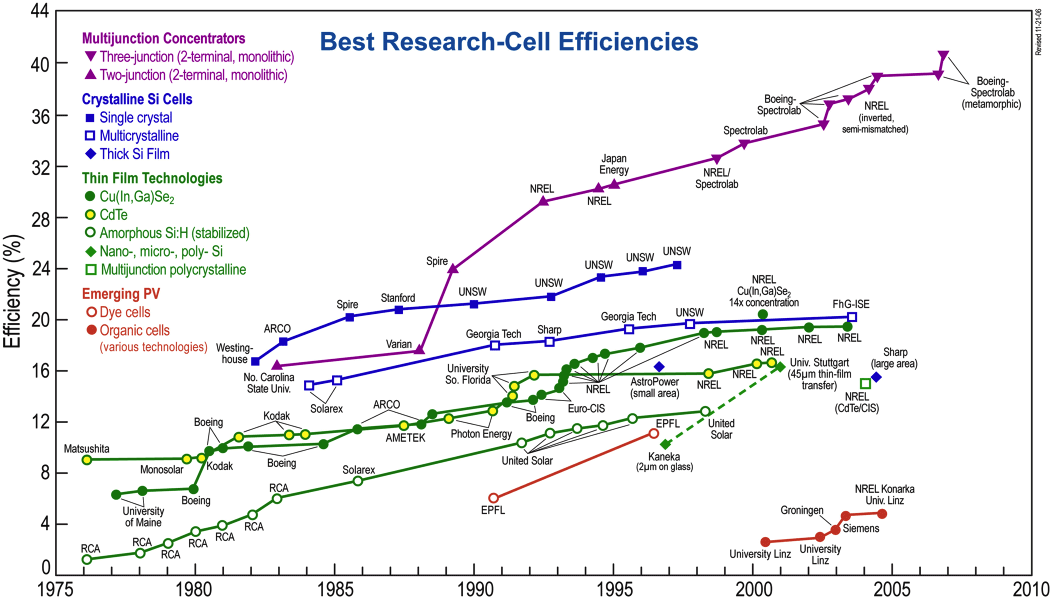L'ENERGIE PHOTOVOLTAÏQUE
TECHNIQUE SOLAIRE PV
Tentative de suivi des records
Superefficient, Cost-Effective Solar Cell Breaks Conversion Records
(http://www.sciam.com/)
| A tiny solar cell doubles the efficiency
of common photovoltaics' conversion of sunlight to electricity by capturing
the energy from a broader spectrum of light.
A tiny chip similar to the solar cells carried by many satellites and other spacecraft today--including the surprisingly long-lived Mars Rovers--has shattered previous records for maximum efficiency in producing electricity from sunlight. "This is the photovoltaic equivalent of the four-minute mile," affirms Larry Kazmerski, director of the Department of Energy's National Center for Photovoltaics in Colorado. "This is a disruptive technology that eventually could provide us, at least in the Southwest, with cost-competitive electricity fairly quickly." The specifics: a germanium wafer is spun at high speeds and subjected to various gases that encourage the growth of layers of semiconducting material such as gallium arsenide. "We have somewhere between 20 and 30 layers of semiconductor material," explains David Lillington, president of Spectrolab, Inc., which developed the new cell. The resulting layers in one single solar device respond to different spectra of light. The top layer, for example, captures the energy of blue light while the middle layer absorbs green and the bottom uses red. Such triple-junction solar cells are specially tuned to work with concentrated light, in this case the wattage of 240 suns. The resulting efficiency nearly doubles that of standard silicon solar cells, which hover at 22%. That gain requires, however, the use of light-concentrating devices, such as miniature plastic lenses and mirrors. The new solar cell achieved 40.7% efficiency under such concentrated light at the testing center at the National Renewable Energy Laboratory in Colorado. One cell of just 0.26685 square centimeter (or roughly 0.04 square inch) pumped out 2.6 watts of electricity when bathed at the maximum light concentration. "Every five minutes the spectrum of the sun changes," Kazmerski explains. So tests are conducted "under a simulator where everything stays constant." Even though installed cells would require concentrators, the fact that fewer cells can produce the same amount of power--and that similar cells are already widely produced--means this system could potentially generate electricity in the range of 8 to 10 cents/kWh--roughly equal to consumer electricity prices today. "Eventually it's hoped that it will come down enough to rival the price of traditional energy although that is future tense," notes Dave Garlick, a spokesman for Spectrolab's parent company Boeing. "This could mean a significant increase in the penetration of solar power," says Clark Gellings, vice president of innovation at the Electric Power Research Institute, a think tank. "The real barrier was the cost of the device." |
Many utilities have already invested in solar, including giant solar
farms in Portugal and China. In the U.S., Xcel Energy plans to build a
relatively modest eight-megawatt solar power plant in Colorado next year
using similar concentrated solar cells as well as other technology. "This
is not a technology that is 10 years away," Kazmerski adds. "This
is a technology that we are going to see out working next year."
Nevertheless, the record-breaking solar cells are at least 12 months away from full-scale manufacturing, Lillington says. "Before we put this new cell into production it needs to go through a qualification process to make sure it can withstand the rigors of the environment." Of course, its Martian peers have lasted 28 months in that harsh, alien environment. And the triple-junction solar cell may not hold the efficiency record for long. "We are also looking at four-, five-, even six-junction solar cells," Lillington notes. "There are at least three or four different approaches to take the efficiency into the 45% range." And that means the price of energy harvested directly from the sun will continue to drop. Performance record pour des cellules solaires conçues aux Etats-Unis LE MONDE | 14.12.06 C'est une prouesse technologique qui va ravir les promoteurs des énergies renouvelables. La société Boeing-Spectrolab, soutenue par le département de l'énergie américain, vient de mettre au point des modules photovoltaïques - qui transforment directement le rayonnement solaire en électricité - dont le rendement, c'est-à-dire le rapport entre l'énergie électrique produite et l'énergie solaire reçue, atteint 40,7%. Le précédent record, établi par le même fabricant, était de 37%. L'Europe, qui développe le projet Full Spectrum auquel est associé le CEA, ne dépasse pas les 35,2%. Ces performances sont à comparer à celles obtenues avec les panneaux photovoltaïques traditionnels à base de silicium, qui plafonnent à 26% en laboratoire, et seulement à 17% pour les productions industrielles. Alors que les cellules classiques tirent parti de l'ensoleillement naturel, celles de Boeing-Spectrolab intègrent des concentrateurs optiques - des lentilles de Fresnel - qui focalisent les rayons solaires. Elles sont en outre constituées de plusieurs couches de métaux semi-conducteurs, en particulier d'arséniure de gallium "dopé" à l'indium, au phosphore, à l'arsenic ou à l'aluminium. De tels systèmes, dits multijonctions, exploitent tout le spectre des longueurs d'onde de la lumière, de l'infrarouge à l'ultraviolet. Avec cette filière, estime Philippe Malbranche, du CEA, un rendement de 45% est théoriquement possible. Mais les composants sont très coûteux, même si le DOE prévoit qu'à terme le prix de revient du kWh descendra à 6 ou 7 ct€. Les modules à concentration sont de plus réservés aux régions à fort ensoleillement direct. Pierre Le Hir
|
